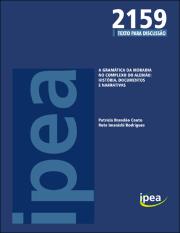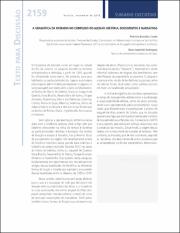Please use this identifier to cite or link to this item:
https://repositorio.ipea.gov.br/handle/11058/6507Full metadata record
| DC Field | Value | Language |
|---|---|---|
| dc.contributor.author | Couto, Patrícia Brandão | - |
| dc.contributor.author | Rodrigues, Rute Imanishi | - |
| dc.coverage.spatial | Rio de Janeiro - RJ | pt_BR |
| dc.coverage.temporal | 2010 | pt_BR |
| dc.date.accessioned | 2016-06-08T15:20:08Z | - |
| dc.date.available | 2016-06-08T15:20:08Z | - |
| dc.date.issued | 2015-11 | - |
| dc.identifier.uri | http://repositorio.ipea.gov.br/handle/11058/6507 | - |
| dc.description.abstract | Este texto tem por objetivo discutir as formas de ler e descrever os distintos modos de fixação e moradia, na evolução do processo de ocupação da área administrativamente reconhecida como Complexo do Alemão. Esta área corresponde a um conjunto de favelas com cerca de 70 mil habitantes, localizado na zona norte do Rio de Janeiro, segundo dados do Censo 2010 (IBGE, 2010).1 O repertório etnográfico que será apresentado neste estudo constituiu-se a partir da memória e perspectiva dos moradores mais antigos dessas comunidades. O propósito desta pesquisa é recuperar os processos históricos que formaram e consolidaram as favelas dessa área, tomando como eixo central de abordagem o histórico fundiário da região e as memórias e experiências de sujeitos sociais que participaram e testemunharam a constituição desse território. | pt_BR |
| dc.language.iso | pt-BR | pt_BR |
| dc.publisher | Instituto de Pesquisa Econômica Aplicada (Ipea) | pt_BR |
| dc.title | A gramática da moradia no Complexo do Alemão : história, documentos e narrativas | pt_BR |
| dc.title.alternative | Texto para Discussão (TD) 2159 : A gramática da moradia no Complexo do Alemão : história, documentos e narrativas | pt_BR |
| dc.type | Texto para Discussão (TD) | pt_BR |
| dc.rights.holder | Instituto de Pesquisa Econômica Aplicada (Ipea) | pt_BR |
| dc.source.urlsource | http://www.ipea.gov.br | pt_BR |
| dc.location.country | BR | pt_BR |
| dc.description.physical | 46 p. : il | pt_BR |
| dc.subject.vcipea | IPEA::Cultura. Sociedade::Sociedade::Condições Sociais. Mudança Social::Desenvolvimento Social | pt_BR |
| dc.subject.vcipea | IPEA::Demografia. População::Habitação. áreas Rurais. áreas Urbanas::áreas Urbanas::Favelas | pt_BR |
| dc.rights.license | É permitida a reprodução deste texto e dos dados nele contidos, desde que citada a fonte. Reproduções para fins comerciais são proibidas. | pt_BR |
| dc.subject.keyword | Complexo do Alemão | pt_BR |
| dc.subject.keyword | Memória social | pt_BR |
| dc.subject.keyword | História das favelas | pt_BR |
| dc.subject.keyword | Estudos urbanos | pt_BR |
| ipea.description.objective | Discutir as formas de ler e descrever os distintos modos de fixação de moradia na evolução do processo de ocupação da área administrativamente reconhecida como Complexo do Alemão. | pt_BR |
| ipea.description.additionalinformation | Série monográfica: Texto para Discussão ; 2159 | pt_BR |
| ipea.description.additionalinformation | Possui referências bibliográficas | pt_BR |
| ipea.access.type | Acesso Aberto | pt_BR |
| ipea.rights.type | Licença Comum | pt_BR |
| ipea.englishdescription.abstract | The Complexo do Alemão, as a place in Rio de Janeiro city, only acquired nominal, administrative and symbolic existence, from 1993, when it was recognized as a neighborhood. However, for its inhabitants, the particularities of the places that compound that administrative place, remain routed on the vast landscape of Serra da Misericórdia, that gathers the favelas of Morro do Alemão, Grota or Joaquim de Queiróz, Nova Brasília, Reservatório de Ramos, Parque Alvorada, Fazendinha, Morro das Palmeiras, Casinhas, Canitar, Pedra do Sapo, Mineiros, Matinha, Morro do Adeus e Morro da Baiana, bordering the neighborhoods of Ramos, Olaria, Higienópolis, Bonsucesso and Inhaúma. Although we are not ignoring the symbolic representation of this area considering its connection to urban violence, this work aims to get back in time and shad some light on peculiarities of the evolution of the ways of stablishing residence on the first settling spots on the region. A previous study on the land history for that large region oriented the field job performed during the year of 2012, in favelas of Morro do Alemão, Grota or Joaquim de Queiróz, Nova Brasília, Reservatório de Ramos, Parque Alvorada, Mineiros e Fazendinha. The aim of the research, based on testimonies of the oldest local people, was to identify the different ways of stablishing residence that explain the settling of those places within the years 1920’s and 1970’s. We identify distinctive definitions for the usage and occupation of land that sprang out of the relations between the land owners and the residents, or their associations, such as: soil renting, allowed occupation, collective invasion, selling of leveled land by neighborhoods associations. We verified also other ways of stablishing residence that derivate from actions between “diffuse actors” and the residents as: invasion to sell (“faveleiro”), squatting and informal selling of land, rent of houses without identification of the owner.The renting and selling of houses or lots were observed as usual practices in all the localities studied. The ethnographic analysis of the accounts presented throughout the text allow the redimensioning of the actual participation and responsibility of both the private sector – in that case represented by local landowners who disseminated and perpetrated the practice of soil renting – and the State – institutionally represented by IAPC and its officers, who distributed land based on personal preference. Therefore, the origin of these slums is not the result of “invasions”. On the contrary, the invasions that actually happened, according to the narratives, were the result of other and previous situations, which we intend to demonstrate. | pt_BR |
| ipea.researchfields | N/A | pt_BR |
| ipea.classification | Desenvolvimento Social | pt_BR |
| ipea.classification | Sociedade. Participação Social. Controle Social | pt_BR |
| Appears in Collections: | Desenvolvimento Social: Livros Sociedade. Participação Social. Controle Social: Livros | |
Files in This Item:
| File | Description | Size | Format | |
|---|---|---|---|---|
| td_2159.pdf | 2.67 MB | Adobe PDF |  View/Open | |
| td_2159_sumex.pdf | 37.61 kB | Adobe PDF |  View/Open |
Items in DSpace are protected by copyright, with all rights reserved, unless otherwise indicated.

